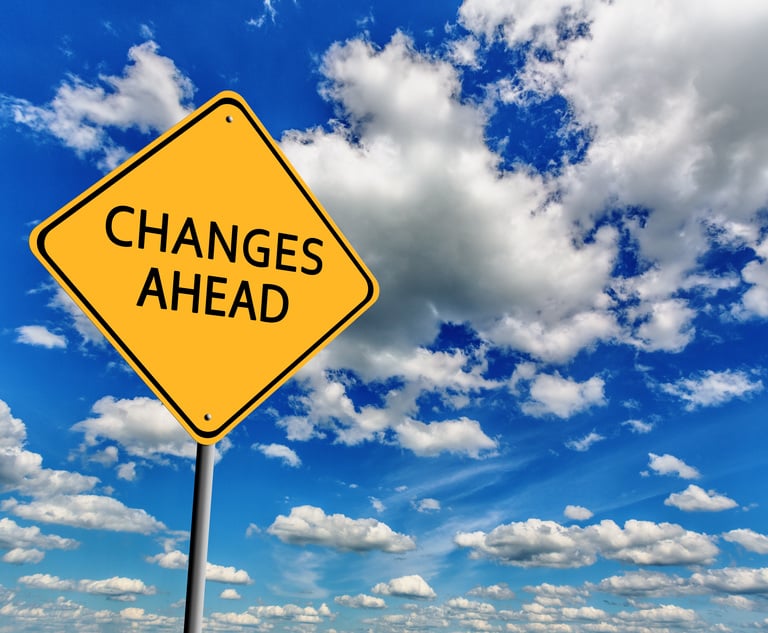White Men Aren't So Keen on Diversity Efforts
The most anodyne measures to increase diversity in the workplace get the most support, according to a recent study.
October 15, 2019 at 06:38 PM
4 minute read
 Photo: Shutterstock.
Photo: Shutterstock.
I can't think of the last time I talked to someone in Big Law who wasn't gung-ho about diversity. Everyone knows the spiel—a diverse team produces better results, diversity is what clients demand, it's the wave of the future. Yada. Yada.
But here's what gets people all hot and bothered: how hard and how far to push the status quo?
 The answer: Not much. According to a report on attitudes about diversity programs in the Harvard Business Review, there's not much appetite to do anything that might offend the existing order. Using data from a 2015 survey of 1,862 workers—white, black and Hispanic—in a broad spectrum of industries and occupations, the study looked at people's attitudes to eight types of diversity policies, ranging from voluntary training to numerical diversity goals.
The answer: Not much. According to a report on attitudes about diversity programs in the Harvard Business Review, there's not much appetite to do anything that might offend the existing order. Using data from a 2015 survey of 1,862 workers—white, black and Hispanic—in a broad spectrum of industries and occupations, the study looked at people's attitudes to eight types of diversity policies, ranging from voluntary training to numerical diversity goals.
The result? I bet you can guess: The most anodyne—and least effective (in my opinion)—measures got the most support.
"Voluntary training and the establishment of a diversity office received the most support," reports HBR. "Two other policies that have also been shown to be effective strategies, targeted recruitment and the establishment of accountable diversity goals, were the least popular."
That's the big, general picture, but there are differences among respondents. And yes, those differences come down to gender and race/ethnicity. For instance:
- Black workers are more likely to support diversity policies, with 50% or more favoring targeted recruitment, voluntary and mandatory training, mentorship and a dedicated diversity office.
- Among whites, there was more support for policies aimed at increasing representation of women than racial minorities (43% and 23% support, respectively), while black and Latinx workers favored people of color.
- Women are more likely to support diversity policies, with 50% or more voicing support for voluntary and mandatory training, and the creation of a diversity office.
- Men reach 50% support only on voluntary training and diversity office.
- Whites and men are least likely to believe that discrimination causes race/gender inequality. They attributed differences to job training. (Just 36% of whites believe discrimination causes inequality.)
- But vast majority of black and Latinx workers (85% and 58%, respectively) believe discrimination causes inequality.
We've been here before: Those white guys can't really fathom why women and minorities still struggle so in the workplace.
And who can blame those hapless souls? Being a woman or a minority or a female minority is beyond the realm of their experience. They know what they know—which is that they showed up, plugged away and hewed closely to the script—and it all worked. So why can't the rest of them do the same?
That attitude, I think, is why those in power are so reluctant to embrace policies that go beyond enunciating the platitudes about the benefits of a diverse work force or designating a diversity center that's powerless. It's also why we'd rather talk about training or skills rather than set goals that would put the onus on the organization.
Interestingly, that's a narrative that even minorities have bought into too—judging from the tepid rate of support among black and Latinx workers for more forceful measures like formal policies or setting diversity goals. (Whites, blacks and Latinx voice the same level of support for formal policies—around 40%. As for diversity goals, all groups show less than 50% support—the rate for blacks was around 45%, Latinx near 30% and whites below 20%).
And women? I'm sorry to say that they're kinda wimpy too. Just over 30% women support setting diversity goals.
I don't know what I find more frustrating in this study—that those in power just don't get it or that women and minorities are so damn deferential.
In any case, the authors of the study offer some pointers to get buy-in for diversity, including "engaging workers in solving social problems" or having direct conversation with employees about race and gender. They also say that less coercive measures like voluntary training and setting up a diversity office have produced results, although they warn that those efforts "alone are not enough."
Not enough is an understatement.
So after all these years, why are we still tiptoeing around gender and racial disparities? As long as we're this patient, nothing will change.
Contact Vivia Chen at [email protected]. On Twitter: @lawcareerist.
This content has been archived. It is available through our partners, LexisNexis® and Bloomberg Law.
To view this content, please continue to their sites.
Not a Lexis Subscriber?
Subscribe Now
Not a Bloomberg Law Subscriber?
Subscribe Now
NOT FOR REPRINT
© 2025 ALM Global, LLC, All Rights Reserved. Request academic re-use from www.copyright.com. All other uses, submit a request to [email protected]. For more information visit Asset & Logo Licensing.
You Might Like
View All
Change Is Coming With the New Trump Era. For Big Law, Change Is Already Here
6 minute read


Letter From London: 5 Predictions for Big Law in 2025, Plus 5 More Risky Ones
6 minute readTrending Stories
- 1Settlement Allows Spouses of U.S. Citizens to Reopen Removal Proceedings
- 2CFPB Resolves Flurry of Enforcement Actions in Biden's Final Week
- 3Judge Orders SoCal Edison to Preserve Evidence Relating to Los Angeles Wildfires
- 4Legal Community Luminaries Honored at New York State Bar Association’s Annual Meeting
- 5The Week in Data Jan. 21: A Look at Legal Industry Trends by the Numbers
Who Got The Work
J. Brugh Lower of Gibbons has entered an appearance for industrial equipment supplier Devco Corporation in a pending trademark infringement lawsuit. The suit, accusing the defendant of selling knock-off Graco products, was filed Dec. 18 in New Jersey District Court by Rivkin Radler on behalf of Graco Inc. and Graco Minnesota. The case, assigned to U.S. District Judge Zahid N. Quraishi, is 3:24-cv-11294, Graco Inc. et al v. Devco Corporation.
Who Got The Work
Rebecca Maller-Stein and Kent A. Yalowitz of Arnold & Porter Kaye Scholer have entered their appearances for Hanaco Venture Capital and its executives, Lior Prosor and David Frankel, in a pending securities lawsuit. The action, filed on Dec. 24 in New York Southern District Court by Zell, Aron & Co. on behalf of Goldeneye Advisors, accuses the defendants of negligently and fraudulently managing the plaintiff's $1 million investment. The case, assigned to U.S. District Judge Vernon S. Broderick, is 1:24-cv-09918, Goldeneye Advisors, LLC v. Hanaco Venture Capital, Ltd. et al.
Who Got The Work
Attorneys from A&O Shearman has stepped in as defense counsel for Toronto-Dominion Bank and other defendants in a pending securities class action. The suit, filed Dec. 11 in New York Southern District Court by Bleichmar Fonti & Auld, accuses the defendants of concealing the bank's 'pervasive' deficiencies in regards to its compliance with the Bank Secrecy Act and the quality of its anti-money laundering controls. The case, assigned to U.S. District Judge Arun Subramanian, is 1:24-cv-09445, Gonzalez v. The Toronto-Dominion Bank et al.
Who Got The Work
Crown Castle International, a Pennsylvania company providing shared communications infrastructure, has turned to Luke D. Wolf of Gordon Rees Scully Mansukhani to fend off a pending breach-of-contract lawsuit. The court action, filed Nov. 25 in Michigan Eastern District Court by Hooper Hathaway PC on behalf of The Town Residences LLC, accuses Crown Castle of failing to transfer approximately $30,000 in utility payments from T-Mobile in breach of a roof-top lease and assignment agreement. The case, assigned to U.S. District Judge Susan K. Declercq, is 2:24-cv-13131, The Town Residences LLC v. T-Mobile US, Inc. et al.
Who Got The Work
Wilfred P. Coronato and Daniel M. Schwartz of McCarter & English have stepped in as defense counsel to Electrolux Home Products Inc. in a pending product liability lawsuit. The court action, filed Nov. 26 in New York Eastern District Court by Poulos Lopiccolo PC and Nagel Rice LLP on behalf of David Stern, alleges that the defendant's refrigerators’ drawers and shelving repeatedly break and fall apart within months after purchase. The case, assigned to U.S. District Judge Joan M. Azrack, is 2:24-cv-08204, Stern v. Electrolux Home Products, Inc.
Featured Firms
Law Offices of Gary Martin Hays & Associates, P.C.
(470) 294-1674
Law Offices of Mark E. Salomone
(857) 444-6468
Smith & Hassler
(713) 739-1250









